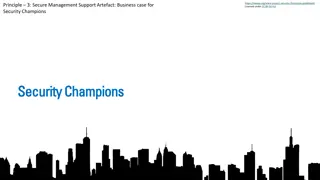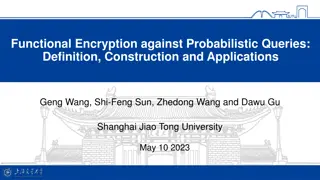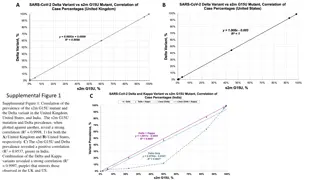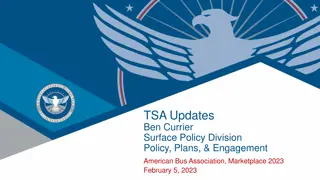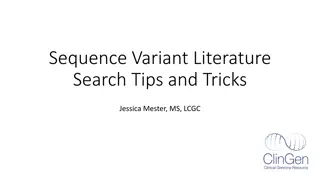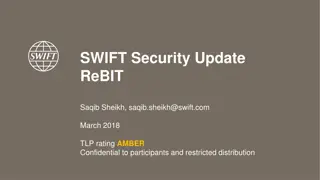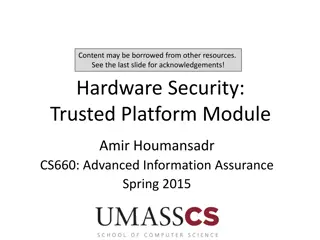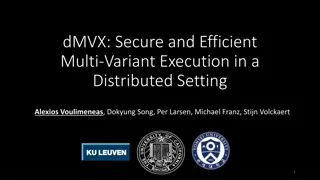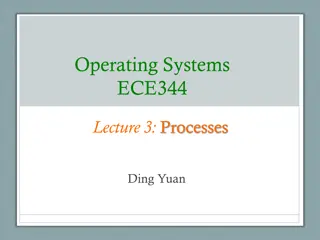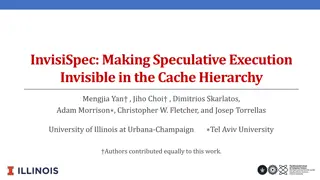N-Variant Execution for Improved Security Measures
N-Variant Execution (NVX) is a technique used to enhance security measures by running diversified program variants in parallel and comparing their outputs for transparency. NVX systems can protect against attacks relying on knowledge of virtual address spaces but have limitations against attacks based on internal program structures. Key examples include ProFTPD SSL key leakage and Position-independent Code Reuse exploits. Further exploration is needed to expand diversity beyond platform constraints.
Download Presentation

Please find below an Image/Link to download the presentation.
The content on the website is provided AS IS for your information and personal use only. It may not be sold, licensed, or shared on other websites without obtaining consent from the author. Download presentation by click this link. If you encounter any issues during the download, it is possible that the publisher has removed the file from their server.
E N D
Presentation Transcript
Distributed Heterogeneous N-Variant Execution Alexios Voulimeneas, Dokyung Song, Fabian Parzefall, Yeoul Na, Per Larsen, Michael Franz, Stijn Volckaert 1
Solutions Type-Safe Programming Languages (e.g. Rust) Type-Safe Programming Languages (e.g. Rust) Mitigations: Integrity Enforcement (e.g. CFI) Software Diversity (e.g. ASLR) Software Diversity (e.g. ASLR) N-Variant eXecution (NVX) Mitigations: Integrity Enforcement (e.g. CFI) 3
N-Variant eXecution (NVX) In a nutshell: Follower Variant Run multiple diversified program variants in parallel Leader Variant Execute these variants in lockstep on identical inputs t t Suspend them at every system call write brk brk write Compare system call numbers/arguments Monitor I/O replication for transparency and identical inputs Kernel 4
What NVX Systems can do Protect Against Attacks that rely on knowledge of the target's absolute virtual address space layout Attacks that attempt to acquire that knowledge through information leakage 5
What NVX Systems cannot do Protect Against Attacks that build on knowledge of the program's internal geometry (e.g., khrelative data/instruction layouts) and/or data representation 6
ProFTPD SSL Private Key Leak (DOP) Hu et al. build an information disclosure attack on ProFTPD - Traverse 6 data structures using only data-only gadgets, ultimately reaching a private key 7
Position-independent Code Reuse (PIROP) G ktas et al. construct code-reuse exploits that use relative locations in memory Attackers could locate PIROP gadgets even in diversified programs 8
Problem: Diversity is limited to what a single platform can offer. Can we do better? 9
Distributed Heterogeneous N-Variant Execution The first distributed heterogeneous NVX design - Variants run in different physical machines - Leverage ISA and ABI heterogeneity to increase diversity 10
Sources of Additional Diversity (ISA-Heterogeneity) Machine instructions Endianness Register set Pointer width Available system calls 11
Sources of Additional Diversity (ABI-Heterogeneity) Size of primitive data types Structs layout - Packing - Alignment - Padding Constants - System call numbers - Flags and modes Calling conventions 12
Distributed Heterogeneous NVX Design Leader Variant Follower Variant syscall (...) syscall (...) Inter-Monitor Communication via Network Monitor Monitor Kernel Kernel 13 Physical host 1 Physical host 2
Challenges False Alarms Performance 14
False Alarms ISA ISA- -Heterogeneity Heterogeneity ABI ABI- -Heterogeneity Heterogeneity Size of primitive data types Structs layout - Packing - Alignment - Padding Constants - System call numbers - Flags and modes Calling conventions Machine instructions Endianness Register set Pointer width Available system calls 15
Additional Diversity ISA ISA- -Heterogeneity Heterogeneity ABI ABI- -Heterogeneity Heterogeneity Size of primitive data types Structs layout - Packing - Alignment - Padding Constants - System call numbers - Flags and modes Calling conventions Machine instructions Endianness Register set Pointer width Available system calls 16
Monitoring the system call interface (NVX) NVX System Variant 1 Variant 2 17
Monitoring the System Call Interface (NVX) NVX System ? = Extracted system call state Extracted system call state Variant 1 Variant 2 18
Monitoring the System Call Interface (NVX) NVX System F Extracted system call state Extracted system call state Variant 1 Variant 2 19
Monitoring the System Call Interface (NVX) NVX System ? = Extracted system call state Extracted system call state Variant 1 Variant 2 20
Monitoring the System Call Interface (NVX) NVX System Extracted system call state Extracted system call state Variant 1 Variant 2 21
Monitoring the System Call Interface (NVX) NVX System ? = Canonicalized system call state Canonicalized system call state Extracted system call state Extracted system call state Variant 1 Variant 2 22
Monitoring the System Call Interface (NVX) NVX System F Canonicalized system call state Canonicalized system call state Extracted system call state Extracted system call state Variant 1 Variant 2 23
Anatomy of a System Call State system call state constant parameters variable parameters simple variables complex structures flags and modes syscall number 24
Differences at System Call Interface System call numbers System calls Struct layout Flags and modes 25
Platform-Independent State Canonicalization (PISC) Canonicalize constants Canonicalize struct layout Use semantic equivalence rules 26
Semantic Equivalence Rules (PISC) Variant 1 open(filepath, flags, mode) Physical host 1 Variant 2 Physical host 2 openat(dir, filepath, flags, mode) 27
Semantic Equivalence Rules (PISC) Variant 1 open(filepath, flags, mode) Physical host 1 False Alarm Variant 2 Physical host 2 openat(dir, filepath, flags, mode) 28
Semantic Equivalence Rules (PISC) Variant 1 open(filepath, flags, mode) Physical host 1 Functional Equivalent Variant 2 Physical host 2 openat(dir, filepath, flags, mode) 29
Semantic Equivalence Rules (PISC) Variant 1 open(filepath, flags, mode) Physical host 1 False Alarm Variant 2 Physical host 2 openat(dir, filepath, flags, mode) 30
Semantic Equivalence Rules (PISC) Variant 1 open(filepath, flags, mode) Resolve absolute file paths before checking Physical host 1 Variant 2 Physical host 2 openat(dir, filepath, flags, mode) 31
Semantic Equivalence Rules (PISC) Variant 1 open(filepath, flags, mode) Physical host 1 False Alarm Variant 2 Physical host 2 openat(dir, filepath, flags, mode) 32
Semantic Equivalence Rules (PISC) Variant 1 open(filepath, flags, mode) Physical host 1 Constant Canonicalization Variant 2 Physical host 2 openat(dir, filepath, flags, mode) 33
Challenges False Alarms Performance 34
Expensive Inter-Monitor Communication Latency - TCP - Reliable UDP - Custom TCP/IP stack Roundtrip time - Avoid inter-monitor communication (when possible) 35
Optimizations Monitoring and replication are expensive Avoid monitoring and replication when possible - Selective Monitoring - Selective Replication 36
Monitoring Leader Variant Follower Variant syscall syscall Expensive monitoring through the network Monitor Monitor Kernel Kernel 37 Physical host 1 Physical host 2
Selective Monitoring Leader Variant Follower Variant Security Sensitive System Call syscall syscall Expensive monitoring through the network Monitor Monitor Kernel Kernel 38 Physical host 1 Physical host 2
Selective Monitoring Leader Variant Follower Variant Non-Sensitive System Call syscall syscall No monitoring Monitor Monitor Kernel Kernel 39 Physical host 1 Physical host 2
Replication Leader Variant Follower Variant syscall syscall Expensive replication of results through the network Monitor Monitor Kernel Kernel 40 Physical host 1 Physical host 2
Selective Replication (1) Leader Variant Follower Variant read-only file read read Each Variant uses its own copy of the file for read-only operations. Monitor Monitor Kernel Kernel 41 Physical host 1 Physical host 2
Selective Replication (2) Leader Variant Follower Variant Reads immutable state syscall syscall The monitor caches the immutable state Monitor Monitor Kernel Kernel 42 Physical host 1 Physical host 2
Security Performance 43
Case Study: ProFTPD SSL Private Key Leak Hu et al. demonstrated an information disclosure attack on ProFTPD - Traverse 6 data structures using data-only gadgets, ultimately reaching a private key A distributed heterogeneous NVX raises the bar - 4/6 pointer fields needed for this attack are located in different offsets 44
Struct Layout Diversity Benchmark Artificial DMON Nginx 1.14.2 14.52% 91.78% Lighttpd 1.4.52 12.93% 81.90% Redis 5.0.1 27.27% 75.60% ProFTPD 1.3.0 27.38% 85.71% 45
PIROP Gadget Reduction Less than 3.3% of PIROP gadgets survive Almost eliminating PIROP ABI- dependent gadgets (0%-0.318%) 46
Alexios Voulimeneas Email: avoulime@uci.edu 48












